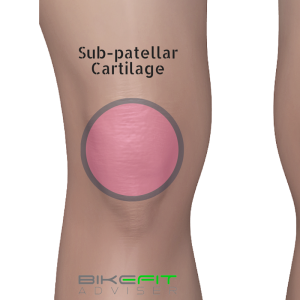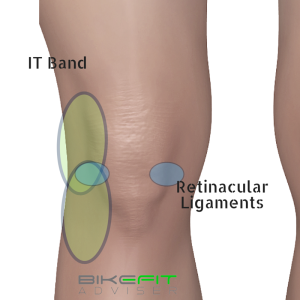5 sources of cycling knee pain
If you're experiencing knee pain on the bike, chances are at least one of these tissues is involved. Often some of these are problematic in tandem ....for instance it's entirely possible for the first three listed to be involved all at once. Ditto for the last two. Regardless, we can often easily narrow down the tissue involved simply by knowing the general area of discomfort.If we know the tissue, we can more easily address the problem and come to a successful solution.In this article, I will note some often overlooked quick fixes in the form of bike fit changes and exercises to help with each but this will not be a complete "how to" for all things cycling knee pain. Shortly I will have a complete module entitled"Beyond Bike Fit: Solving Knee Pain on the Bike" which will provide enough detail to satisfy even an experienced bike fitter but presented and organized in a way to be easily consumed by any athlete regardless of knowledge or experience.Without further ado, let's start with the culprits of cycling knee pain:
1. Patellar tendon & 2. Quad tendon
These two tendons are completely separate structures, but they usually are irritated by the same causes. Both create front of the knee pain; the quadricep tendon lives above the kneecap, the patellar below. Most times if you poke around on the tendons they'll be tender to the touch -- this can differentiate it from sub-patellar cartilage pain which usually won't have tenderness or reproduction of symptoms just by poking around with your fingers. Having too low a saddle height is generally the number one cause of this type of knee pain, although more attention needs to be paid to having the proper crank length since this is also a major determining factor of how much knee flexion occurs at the top of the pedal stroke.
Having too low a saddle height is generally the number one cause of this type of knee pain, although more attention needs to be paid to having the proper crank length since this is also a major determining factor of how much knee flexion occurs at the top of the pedal stroke.
3. Sub-patellar cartilage
If it's difficult to put your finger on where your pain is, either literally or figuratively, then irritation of the sub-patellar cartilage could be a good guess. This pain is usually vague and most athletes point to the entire area under and around the kneecap. A low saddle height can again cause the pain by compressing the kneecap and the cartilage under it into the femur during the maximal knee flexion that occurs at the top of the pedal stroke. An equally common cause is poor alignment of the hip and the knee that causes the kneecap to track poorly in the femoral groove. This mal-alignment can be isolated to the bike or it can be a more pervasive problem that happens off the bike as well.Often bike fit fixes like addressing the stance width of the rider, or perhaps using cleat wedges can be helpful, but in my experience the best long term fix for cyclists is to address the under-lying strength and body-balance issues that generally have to do with hip strength and mobility. Even if you don't have this type of knee pain I find that most cyclists can benefit from hip strengthening exercises like the ones in these videos. Hip 1 | Hip 2 | Hip 3
A low saddle height can again cause the pain by compressing the kneecap and the cartilage under it into the femur during the maximal knee flexion that occurs at the top of the pedal stroke. An equally common cause is poor alignment of the hip and the knee that causes the kneecap to track poorly in the femoral groove. This mal-alignment can be isolated to the bike or it can be a more pervasive problem that happens off the bike as well.Often bike fit fixes like addressing the stance width of the rider, or perhaps using cleat wedges can be helpful, but in my experience the best long term fix for cyclists is to address the under-lying strength and body-balance issues that generally have to do with hip strength and mobility. Even if you don't have this type of knee pain I find that most cyclists can benefit from hip strengthening exercises like the ones in these videos. Hip 1 | Hip 2 | Hip 3
4. IT band & 5. Retinacula ligaments
If you have medial knee pain -- on the inside -- chances are that the ligaments that support the knee joint or hold the kneecap in place are part of the problem. Yes, the medial meniscus can cause medial knee pain as well, but generally if you have meniscal damage that's severe enough to cause pain on the bike, then you also have pain during non-bike activities and likely have bigger fish to fry. If you have lateral pain then the IT Band might be the culprit, but it often works hand in hand with the retinacular ligaments -- they're virtually impossible to separate since the IT Band has an attachment to these ligaments. IT pain is hallmarked often by pain from the lateral side of the lower thigh all the way down to the outside of the calf.If you have lateral pain often this can be caused by too high a saddle height or a predisposition to excessive "toe down" pedaling style which can both cause a twist in the tibia.If you have medial pain the possible causes and fixes are many -- hip strengthening exercises, cleat wedges, cleat stance adjustments, handlebar reach and height changesIf you're having knee pain on the bike, sometimes just pin-pointing where it is will tell you what tissue is involved. Once you know what tissue, understanding how to fix it is much easier to grasp.
If you have lateral pain then the IT Band might be the culprit, but it often works hand in hand with the retinacular ligaments -- they're virtually impossible to separate since the IT Band has an attachment to these ligaments. IT pain is hallmarked often by pain from the lateral side of the lower thigh all the way down to the outside of the calf.If you have lateral pain often this can be caused by too high a saddle height or a predisposition to excessive "toe down" pedaling style which can both cause a twist in the tibia.If you have medial pain the possible causes and fixes are many -- hip strengthening exercises, cleat wedges, cleat stance adjustments, handlebar reach and height changesIf you're having knee pain on the bike, sometimes just pin-pointing where it is will tell you what tissue is involved. Once you know what tissue, understanding how to fix it is much easier to grasp.

